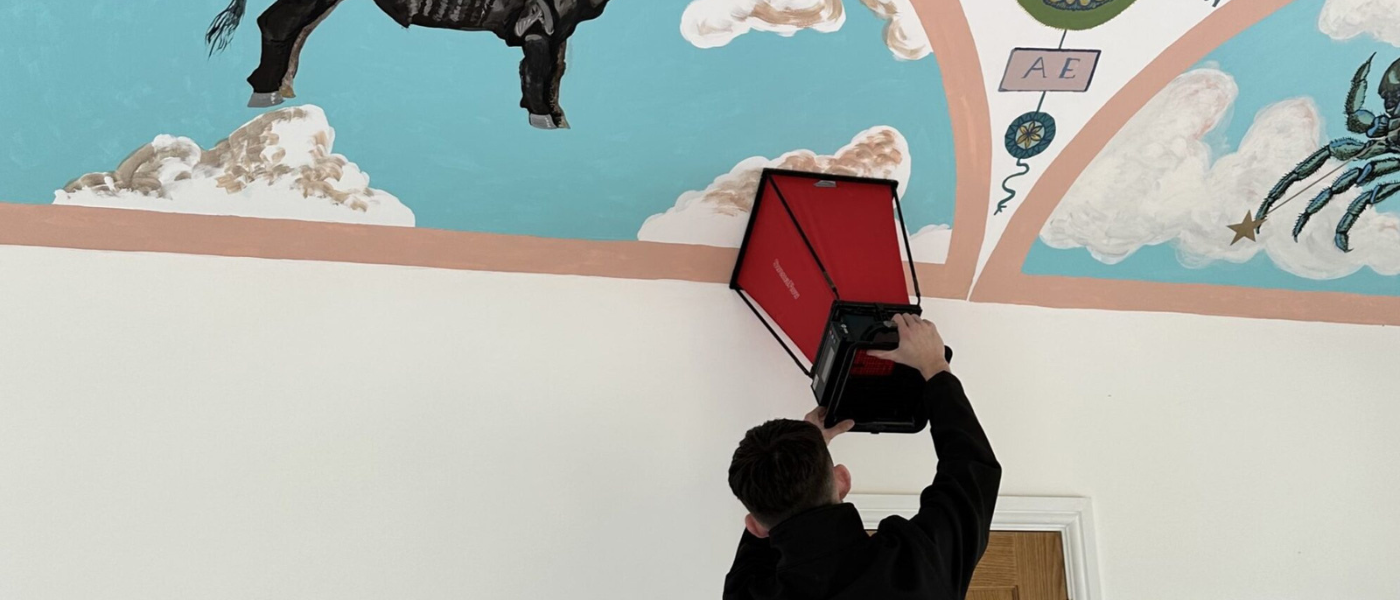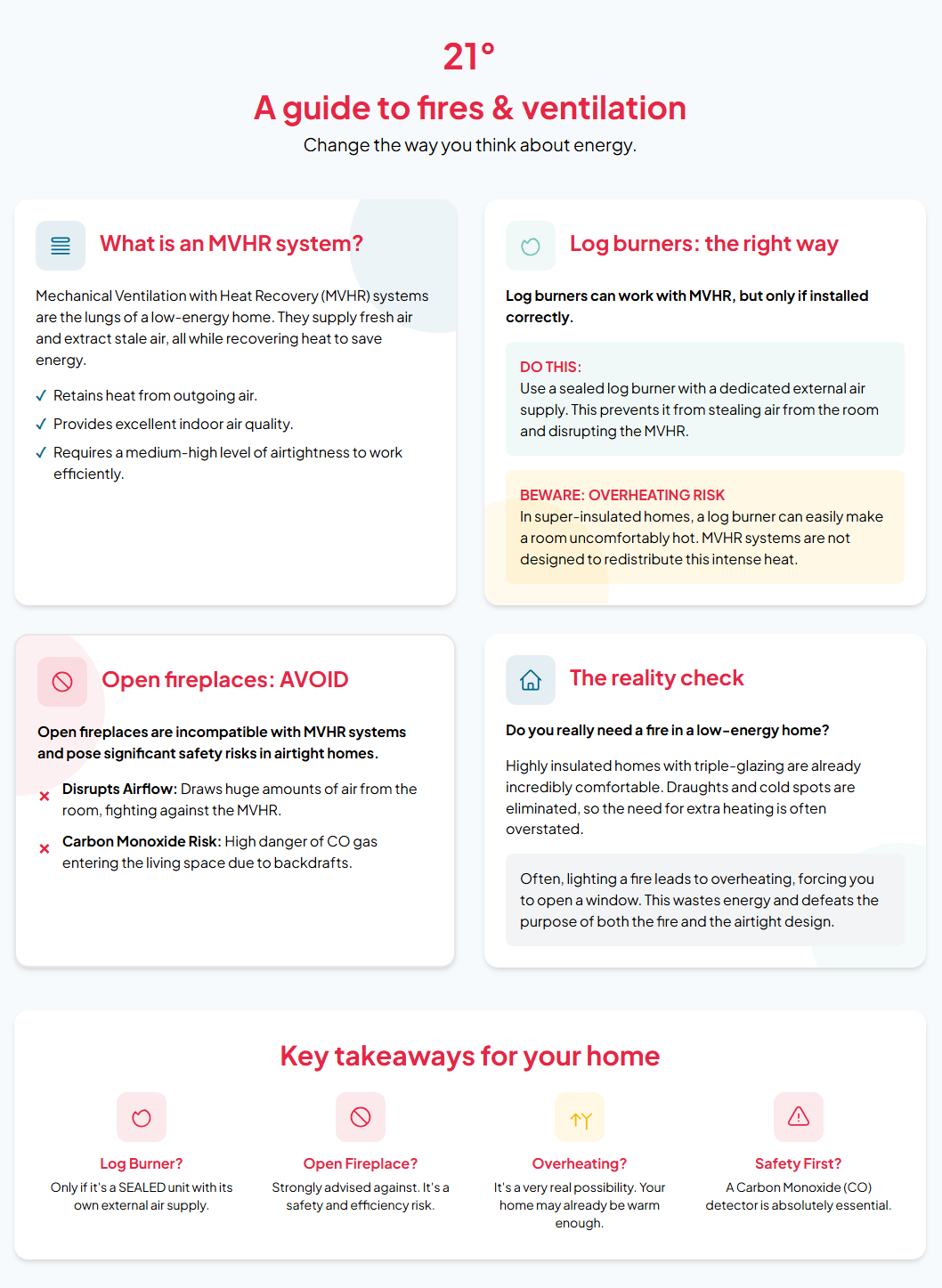Log Burners, Open Fireplaces, and MVHR Systems in Low-Energy Homes

Faced with escalating energy prices, a growing number of UK households are adopting log burners and open fireplaces for supplementary heating. While these installations provide a warm and inviting atmosphere, their health implications are significant.
Domestic solid fuel combustion, encompassing wood, coal, and smokeless fuels, stands as the United Kingdom's primary contributor to fine particulate matter air pollution, accounting for 27% of all PM2.5 emissions. It is important to note that even homes equipped with modern "Ecodesign" burners exhibit indoor pollution levels three times greater than those in homes without such appliances.
Exposure to this type of particulate pollution is correlated with an increased risk of mortality from heart disease, lung disease, and lung cancer. Furthermore, it is associated with the development of diabetes, can impair brain health leading to dementia, and poses a risk to foetal development. Inhaling pollutants from indoor burning specifically elevates the risk of lung cancer and other respiratory conditions.
However, integrating log burners or open fireplaces into homes equipped with Mechanical Ventilation with Heat Recovery (MVHR) systems, commonly found in low-energy or Passivhaus designs, requires careful consideration.
Here we explore the compatibility of log burners and open fireplaces with MVHR systems, addresses common misconceptions, and highlights why these heating solutions may not always be necessary in well-insulated homes.
Understanding MVHR Systems

MVHR systems are designed to provide fresh air while retaining heat in energy-efficient homes. They work by extracting stale air from spaces like kitchens and bathrooms and supplying fresh air to living areas and bedrooms. As the outgoing air passes through a heat exchanger, it transfers warmth to the incoming air, maintaining a comfortable indoor temperature with minimal energy loss. In low-energy homes, such as those built to Passivhaus standards, MVHR systems are integral to achieving exceptional thermal performance, reducing heating demands, and ensuring consistent indoor air quality.
These systems rely on a tightly sealed building envelope to prevent uncontrolled air leakage, which can undermine energy efficiency. This airtightness poses challenges when introducing combustion-based heating systems like log burners or open fireplaces, as they require oxygen to function and can disrupt the delicate balance of air pressure within the home.
Should I Have a Log Burner If I Have an MVHR System?
Log burners can be installed in homes with MVHR systems, but only under specific conditions. The most critical requirement is that the log burner must be a sealed unit with a dedicated external air supply ducted directly to it. This setup ensures the burner draws air for combustion from outside the home, preventing draughts or air leakage through the building fabric. Without this dedicated air supply, the log burner could depressurize the room, pulling air through unintended pathways and compromising the MVHR system’s efficiency.
However, even with a sealed log burner, homeowners should be aware of potential challenges. In well-insulated homes with triple-glazed windows and minimal heat loss, the radiant heat from a log burner can quickly make the room uncomfortably warm. A common misconception is that MVHR systems will redistribute this heat evenly throughout the house.
In reality, MVHR systems are designed to manage ventilation, not to act as a heat distribution system. While warm air from the room with the log burner may move toward nearby extract vents, only a small portion of that heat is recovered and transferred to other rooms. As a result, the heat remains localized, potentially leading to overheating in the space where the burner is installed.
The Reality of Log Burners in Passivhaus Designs
The appeal of a log burner—curling up under a blanket in front of a cosy fire during winter—is undeniable. However, in highly insulated homes, the need for such a heat source is often overstated.
People who have installed log burners in their own Passivhaus homes, report that they rarely use them. In a well-insulated house with triple-glazed windows, radiant coolth (the cold sensation from poor glazing) and draughts caused by convection from substandard windows are virtually eliminated. This creates a consistently comfortable indoor environment without the need for additional heating.
Lighting a log burner in such a home can lead to overheating, prompting residents to open windows to cool the space. This introduces cold air into the building's thermal envelope, opening air in one room wont cool only that one room down, but the whole house. As some of the rooms will now be cooler, below comfort temperature, the heating system will increase its output for those cold spaces, reducing efficiency and increasing operational costs. As a result, the romanticized vision of a log burner may not align with the practical realities of living in a low-energy home, where the fire is often left unlit.
Open Fireplaces: A Risky Choice
Open fireplaces are incompatible with MVHR-equipped homes and are not recommended. Unlike sealed log burners, open fireplaces draw air directly from the room, which can disrupt the MVHR system’s carefully controlled airflow.
More critically, open fireplaces pose a significant risk of carbon monoxide (CO) entering the living space due to incomplete combustion or backdrafts. This is particularly concerning in airtight homes, where any combustion gases that enter the room may not be adequately vented.
and any room with an open fireplace must be equipped with a functioning carbon monoxide detector as a critical safety measure.
Key Considerations for Homeowners
When deciding whether to install a log burner or open fireplace in a home with an MVHR system, consider the following:
- Sealed Log Burners Only: Ensure the log burner is a sealed unit with a dedicated external air supply to maintain the integrity of the MVHR system and prevent air leakage.
- Avoid Open Fireplaces: Due to the risks of carbon monoxide and disruption to the MVHR system, open fireplaces are not advisable in low-energy homes.
- Carbon Monoxide Detectors: If an open fireplace is installed, a carbon monoxide detector is essential in the room to protect occupants from potential hazards.
- Overheating Risks: In well-insulated homes, log burners can cause localized overheating, making them less practical than anticipated.
- MVHR Limitations: MVHR systems are not designed to redistribute heat from a log burner throughout the house, so expect the heat to remain concentrated in one area.

The Bigger Picture: Do You Really Need a Fire?
While the aesthetic and emotional appeal of a log burner or open fireplace is strong, their practicality in a low-energy home is questionable. The exceptional insulation, airtightness, and triple-glazed windows in Passivhaus or similar designs create a stable, comfortable indoor environment without the need for supplemental heating. The absence of draughts and radiant coolth means that the cozy warmth of a fire may feel redundant. Homeowners may find that the effort and cost of installing and maintaining a log burner, combined with the potential for overheating, outweigh the benefits.
Instead, consider leveraging the full potential of your MVHR system and other energy-efficient features. These systems are designed to maintain a consistent temperature and high air quality, reducing reliance on additional heating sources. For those still drawn to the ambiance of a fire, a sealed log burner with proper installation can be a viable option, but it’s worth reflecting on whether it will be used enough to justify the investment.
Conclusion
Log burners and open fireplaces can add charm and warmth to a home, but their compatibility with MVHR systems in low-energy or Passivhaus designs is limited. Sealed log burners with dedicated air supplies are the only safe and practical option, while open fireplaces carry significant risks and are best avoided.
Even with a compatible log burner, the exceptional thermal performance of a well-insulated home may render it unnecessary, as overheating and the need to open windows can negate the benefits of both the fire and the MVHR system. By understanding these dynamics, homeowners can make informed decisions that balance aesthetics, comfort, and energy efficiency in their low-energy homes.
If you have questions concerning any of the points in this article, or if you would like to discuss MVHR or any of our products, get in touch with 21 Degrees today.







